Edith Maxwell's Blog, page 281
July 17, 2014
A Book’s Exact Right Moment with Lori Rader-Day
 Sherry: Lori thanks so much for joining us today. I meet Lori at Left Coast Crime last March. We were co-panelist on Deadly New Voices. Her book The Black Hour debuted last week to great reviews.
Sherry: Lori thanks so much for joining us today. I meet Lori at Left Coast Crime last March. We were co-panelist on Deadly New Voices. Her book The Black Hour debuted last week to great reviews.
Lori: Let me get this part out of the way: I hated Anne of Green Gables.
Oh, and A Wrinkle in Time.
Are you still here? What if I say that I only got up to the front door of Mr. Rochester’s house in Jane Eyre before I fell asleep, dropped the book, and never picked it up again.
Don’t get me wrong. I love kid books. I side with #teamYA in the recent kerfuffle over whether adults should be ashamed to read books written for young people. (Ashamed? Really?)
The problem with these books is that I didn’t try to read any of them until far into my adulthood—and it was too late. I’ve found that if I didn’t come to love a book at the proper time of my life, it might not be possible to go back and right the wrong.
There’s no time limit on these books. They’re classics. But they are classics meant for girls of a certain age, a certain age I haven’t been in a long (long) time.
By the time I read Anne of Green Gables, Anne struck me as a hyperactive goody-goody. I didn’t even understand A Wrinkle in Time. It was about…time? It just ended abruptly, I noticed. Leaving room for the sequels, thought my jaded, adult self. As for Jane Eyre: Oh, Jane. He has a crazy wife in the attic. Girlfriend, you can do better.
On the other hand, books that I read and loved as a kid still hold sway over me. I’ve re-read some of them as an adult and you know what? They’re just as awesome as they always were. These are books like A.A. Milne’s Winnie-the-Pooh stories, on which my childhood was built and in which as an adult I found some sage writing advice. Or E.L. Konigsberg’s From the Mixed-Up Files of Mrs. Basil E. Frankweiler. Sure, the kids running away from home gave me more pause than it once did, but I still rooted for them to get away with it. Scott O’Dell’s The Island of the Blue Dolphin—check, except now I kind of want a summer house on that cove instead of being rescued from it. Alice in Wonderland? This book was probably never for children anyway, but that’s beside the point—I read it as a kid, loved it, and have read it as an adult. It holds up.
Except it’s not the book holding up to some standard. It’s the reader. It’s us. It’s me. I’m the one who comes to the pages different than I was last time. I’m the variable that changes over time. The words on the page say what they’ve said my entire life and either they resonate with me or they don’t. The difference is me—did I read this book long ago and leave a piece of myself in the text? For the books I never read when I was supposed to, the question is different. Can I find something in the text to latch onto now?
Now that I’m a writer with deadlines, I get less reading done. Combine that with the vast number of great mysteries I encounter at every conference I attend, where I’m meeting great new authors I want to support, and we have a problem of supply and demand. Supply, supply, and demand. I’ll never read everything I want to. (Thanks a lot, mortality.) I have to be more selective with my reading time.
More than that—I hope I have left something of myself on the pages I’ve written for someone else to find at the exact right time. And, someday, they can tear my Winnie-the-Pooh out of my cold, dead hands. I’m not ashamed to say it.
Readers: Did you read any books that just weren’t “in the moment”?
 Lori Rader-Day is the author of the mystery The Black Hour (Seventh Street Books, 2014). Born and raised in central Indiana, she now lives in Chicago with her husband and dog. Her fiction has appeared in Ellery Queen Mystery Magazine, Good Housekeeping, Time Out Chicago, and others. Visit her at LoriRaderDay.com.
Lori Rader-Day is the author of the mystery The Black Hour (Seventh Street Books, 2014). Born and raised in central Indiana, she now lives in Chicago with her husband and dog. Her fiction has appeared in Ellery Queen Mystery Magazine, Good Housekeeping, Time Out Chicago, and others. Visit her at LoriRaderDay.com.
Filed under: Guest posts Tagged: Left Coast Crime, Lori Rader-Day, The Black Hour

July 16, 2014
Wicked Wednesday – Secondary Characters
It’s Wicked Wednesday, when we all weigh in on a topic. Today, we’re still chatting about characters – namely, the cast of supporting characters who are often equally as important to our stories as our main character. So Wickeds, tell us about some of the inhabitants in your towns.
Barb: Readers often ask if the inhabitants of Busman’s Harbor are based on real people. The one people always ask about is Gus, the cranky restaurateur who doesn’t want anyone he doesn’t know personally in his restaurant. There really was a Gus and he really had that rule. Here’s what I’ve written about the real restaurant. 
“Gus’s had old round-topped gas pumps out front like something out of an Edward Hopper painting and two candle pin bowling lanes inside across from the lunch counter. His dining room had fabulous views of the aptly named Cozy Harbor. He prepared the food like he was cooking in his own kitchen (and with the same approximate speed) and you had to order a slice of his wife’s delicious pie when you placed your meal order, or there might not be any left when you were ready for dessert. Maine food writer Karyl Bannister reposted her original writing about the place–a restaurant review distinguished by the fact that she wasn’t allowed to disclose the restaurant’s name or location.
 Both Gus and his wife have sadly passed on. There’s a new restaurant in the spot Oliver’s at Cozy Harbor. The food is wonderful and the new building takes much better advantage of the views. I recommend it to anyone traveling in the area. But I missed Gus’s so much that I created a highly fictionalized version of it in the Maine Clambake Series.”
Both Gus and his wife have sadly passed on. There’s a new restaurant in the spot Oliver’s at Cozy Harbor. The food is wonderful and the new building takes much better advantage of the views. I recommend it to anyone traveling in the area. But I missed Gus’s so much that I created a highly fictionalized version of it in the Maine Clambake Series.”
Jessie: I adore the secondary characters because they present the opportunity to provide humor or quirkiness that might be hard to take from the protagonist. For me they are all vivid and interesting. In a way I find them easier to write because they carry less of the story on their shoulders so I sometimes feel more relaxed and in flow when I am working with them. Some of my very favorites are Augusta, the protagonist’s older sister in my first book, Live Free or Die and Dani’s mother, Kelly, in my Sugar Grove series. Both of those women walked full blown onto the page and spoke their minds. I was enchanted and enjoyed every scene in which they insisted on appearing.
Barb: Jessie, I heard Tess Gerritsen say the same thing, that secondary characters are more vivid because they flow more directly from our subconscious. She said both Rizzoli and Isles were “accidental characters.”
Liz: I love having a cast of regulars who not only help tell the stories, but who often have stories of their own. For me it’s Char Mackey, who is a New Orleans transplant to New England but has never left her traditions behind (like having parties). She presents a lot of opportunities for humor. Also, Frog Ledge’s resident state trooper, who also happens to be the handsome Jake’s sister. She and Stan don’t get along from day one, when Stan is the suspect in her first murder. The conflict between the two of them is so much fun to write!
Edith: On Cam Flaherty’s farm, a group of avid local foods enthusiasts – members of the

Actually my uncle, author Richard Reinhardt, but I love him so much he might as well stand in for Great-Uncle Albert!
Locavore Club – belong to her CSA, her farm share program. The club president is Lucinda, a colorful transplanted Brazilian whom I love, and who is so real to me I feel like I should be able to post her picture. 14-year old Girl Scout Ellie is a continuing character, who volunteers on the farm and provides a breath of fresh air. Probably my favorite is Cam’s great-uncle Albert, who gave her the farm. He’s the wise kindly voice she can go to when she needs a hit of family, of common sense, and of surprise now and then. There’s a handsome Jake in my series too – but will his volatile, jealous nature prove too difficult for Cam to deal with?
Readers: Who are your favorite secondary characters? In our series, who had we better not kill off?
Filed under: Group posts, Wicked Wednesday Tagged: Cam Flaherty, characters, Cozy Harbor, craft, girl scouts, Gus Farnham, Gus Pratt, maine clambake mysteries, organic farming, secondary characters, small town settings, Wicked Wednesday

July 15, 2014
The Detective’s Daughter — The Dog Days of Summer
By Kim Gray in Baltimore City
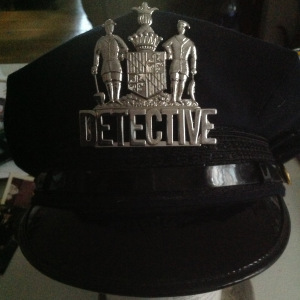 It was going to be another scorching weekend. My grandmother had pinned sheets from the clothesline to the fence to create a tent that would shade the yard. Dad had placed the fans in the windows to draw the heat from the house, and Mom had made at least a few gallons of iced tea. By Sunday the neighborhood was quiet, everyone drained from the heat, motionless indoors with a lucky few enclosed in air-conditioned rooms.
It was going to be another scorching weekend. My grandmother had pinned sheets from the clothesline to the fence to create a tent that would shade the yard. Dad had placed the fans in the windows to draw the heat from the house, and Mom had made at least a few gallons of iced tea. By Sunday the neighborhood was quiet, everyone drained from the heat, motionless indoors with a lucky few enclosed in air-conditioned rooms.
I was sixteen and had too much to do to be bothered by the weather. On this particular weekend I had two babysitting jobs. The first was to mind a neighborhood boy while his parents went on a fishing trip. The second was to care for two dogs so their owners could go to Ocean City. The little boy, whom I will call Jimmy, lived around the corner from me. He was two years old and I watched him every afternoon until his dad came home from work. We had spent many hours together over the past two years, but this was the first time I had kept him overnight.
The couple who lived a few doors down had a baby and two dogs. I had watched the baby on several occasions and had taken care of the dogs every time they had gone away. This weekend was no different from any other.
I took Jimmy to the house with me to feed the dogs. He loved them and had spent time with them due to the fact his parents were not only neighbors to the owners but friends as well. One of the dogs was a large Siberian Husky with beautiful blue eyes. The other was a funny, lanky dog with short brown hair and long ears. He was a Shepard mix. We had fed the dogs and put them in the yard while I made Jimmy a little lunch. The dogs were always very excited when they came back in the house and would jump up on us. I placed Jimmy on a tall stool in the kitchen while I opened the door. I didn’t want the dogs to knock him over.
The screen door slammed shut and I turned to face Jimmy who still sat on the stool, his legs tucked under him. The brown dog passed by and headed for the basement door. The second dog, the Husky, stopped to look at Jimmy. The air was heavy, the fan brought no relief and the only sound was its constant whirl. In one graceful motion the Husky pulled Jimmy from the stool. I picked the boy up, afraid he may have bumped his head. Jimmy seemed fine as I gathered him in my arms. The dog jumped on me, knocked me over and snatched the child from me. I couldn’t understand what was happening. I struggled to regain my balance. The Husky had Jimmy’s shoulder between its teeth and was shaking the boy back and forth. Blood splattered on the tiled floor and the green and white papered walls as I relentlessly pulled at the Husky, trying to free Jimmy from its grip. My hands had streaks of blood on them as I beat the dog’s head and body. Jimmy’s eyes stared blankly at me as his body was thrown back and forth like a rag doll.
I do not remember screaming, though later neighbors from blocks away recalled hearing me. After what seemed like hours, but in actuality was about fifteen minutes, my friend’s dad came charging through the back door with a hammer. When I saw him, I passed out.
The next thing I remember is being checked out by a paramedic. I had sustained no injuries, however Jimmy was being transported to shock trauma by helicopter. Dad went to the hospital with Jimmy while Mom and my grandmother stayed with me, watching intently as the police questioned me.
 There was no way for us to contact Jimmy’s parents. They were out on the Chesapeake in a boat so the Coast Guard was sent to locate them. A few hours later the young parents pulled up alongside our house in their pick-up truck, the mom jumping out before it had come to a complete stop. We watched from our kitchen window as we sat around the table, our dinner untouched. We found out later they’d only been told to return home immediately and weren’t given any other details of the emergency.
There was no way for us to contact Jimmy’s parents. They were out on the Chesapeake in a boat so the Coast Guard was sent to locate them. A few hours later the young parents pulled up alongside our house in their pick-up truck, the mom jumping out before it had come to a complete stop. We watched from our kitchen window as we sat around the table, our dinner untouched. We found out later they’d only been told to return home immediately and weren’t given any other details of the emergency.
Dad stood immediately, instructing me to stay put. It was the first time I’d seen him in this role. There had been a few occasions where I’d witnessed him arresting someone, but I’d never seen this compassionate side where he had to deliver bad news. I was sure he had to do this many times in his line of work, but never had it involved him personally. I stood at the back door as he spoke to Jimmy’s parents. Dad put his hand on the mom’s shoulder as she bent her head and cried. It was then I cried for the first time. Jimmy’s parents piled into Dad’s car and he drove them to the hospital.
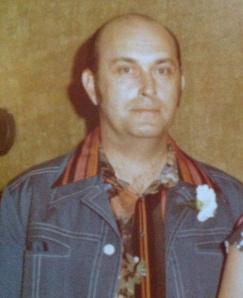 It was a few days before I was allowed to visit Jimmy in the hospital. He had tubes sticking out of his small body from every angle and a large bandage covering his neck. There were stitches in his arm and leg and a few to close a gash near his left eye. It was a miracle that he had survived. Dad stopped every evening to check on him. Although I blamed myself for what happened, no one else did. Jimmy’s family continued to have me babysit once he had fully recovered.
It was a few days before I was allowed to visit Jimmy in the hospital. He had tubes sticking out of his small body from every angle and a large bandage covering his neck. There were stitches in his arm and leg and a few to close a gash near his left eye. It was a miracle that he had survived. Dad stopped every evening to check on him. Although I blamed myself for what happened, no one else did. Jimmy’s family continued to have me babysit once he had fully recovered.
As the years have passed, I not only remember the small boy and that summer afternoon, but my dad and how he taught me the meaning of compassion and composure.
Filed under: The Detective's Daughter Tagged: Baltimore City, Baltimore City Police, The Detective's Daughter

July 14, 2014
Yard Sales and Writing
By Sherry Harris from NoVA
 As you may know I love to go to yard sales. I’ve traveled a lot recently and find it hard to resist a sign that says “yard sale” with a arrow pointing down a block. I went to one in Destin, Florida. The things I loved were way too big to fit in my suitcase. How I would have loved to take the chaise lounge below home.
As you may know I love to go to yard sales. I’ve traveled a lot recently and find it hard to resist a sign that says “yard sale” with a arrow pointing down a block. I went to one in Destin, Florida. The things I loved were way too big to fit in my suitcase. How I would have loved to take the chaise lounge below home.

 But I had a nice chat with the man running the yard sale about his wife’s business of fixing up old furniture. We talked about a desk he had and whether a piece of veneer that was curling up off the top was original or added later.
But I had a nice chat with the man running the yard sale about his wife’s business of fixing up old furniture. We talked about a desk he had and whether a piece of veneer that was curling up off the top was original or added later.
 A couple of weeks later I went to a wedding in Saint Louis, Missouri. I stayed with a friend who also likes yard sales so we set out early on Saturday morning. I found a lovely bedroom set. Of course it wouldn’t fit in the suitcase but I had to ask how much they wanted. Thirty dollars apiece for the bed and dressers — that was his opening price who knows what it would have been with a bit of haggling. One of the dressers had drawers that were dovetailed so I knew it was old.
A couple of weeks later I went to a wedding in Saint Louis, Missouri. I stayed with a friend who also likes yard sales so we set out early on Saturday morning. I found a lovely bedroom set. Of course it wouldn’t fit in the suitcase but I had to ask how much they wanted. Thirty dollars apiece for the bed and dressers — that was his opening price who knows what it would have been with a bit of haggling. One of the dressers had drawers that were dovetailed so I knew it was old.
Writing a novel is a bit like going to a yard sale.
 You have to leave some things behind no matter how much you like them. Faulkner called it killing your darlings. I loved these picnic baskets but no way to jam them in my suitcase.
You have to leave some things behind no matter how much you like them. Faulkner called it killing your darlings. I loved these picnic baskets but no way to jam them in my suitcase.
 You can’t cram too much in to one book. The scenes start to sag or it ends up a mess that people may or may not want to sort through.
You can’t cram too much in to one book. The scenes start to sag or it ends up a mess that people may or may not want to sort through.
 What makes your book unique and stand out in a crowd? When I was at a yard sale in a neighborhood full of them this ladder caught my eye. Not only did it make the yard sale stand out but the ladder had a purpose. Each scene should support the plot or subplot.
What makes your book unique and stand out in a crowd? When I was at a yard sale in a neighborhood full of them this ladder caught my eye. Not only did it make the yard sale stand out but the ladder had a purpose. Each scene should support the plot or subplot.
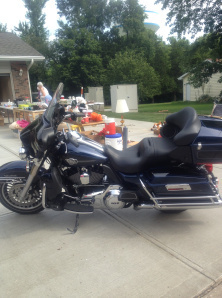
 Until that Saturday in Saint Louis, I’d never seen a Harley for sale at a yard sale. (The guy wanted $21,000 for it, in case you’re curious.) It was unexpected. In writing you have to do the unexpected too. Sometimes I make a list of options a character has in a given situation and pick what might seem like the opposite of what the character should do.
Until that Saturday in Saint Louis, I’d never seen a Harley for sale at a yard sale. (The guy wanted $21,000 for it, in case you’re curious.) It was unexpected. In writing you have to do the unexpected too. Sometimes I make a list of options a character has in a given situation and pick what might seem like the opposite of what the character should do.
 You have to haggle with yourself and decide what you really, really have to keep. The tins in the background caught my eye. Printed on the bottom of the tin is: Designed by Daher in Long Island, NY 11101 Container made in England. The lady told me they were biscuit tins. I have no idea if that’s true. But I loved the bright colors and they fit in my suitcase.
You have to haggle with yourself and decide what you really, really have to keep. The tins in the background caught my eye. Printed on the bottom of the tin is: Designed by Daher in Long Island, NY 11101 Container made in England. The lady told me they were biscuit tins. I have no idea if that’s true. But I loved the bright colors and they fit in my suitcase.
 So two of them came home with me.
So two of them came home with me.
Readers: Do you like yard sales or hate them? Is there anything you can’t resist when you go to one?
Filed under: Sherry's posts, Uncategorized

July 11, 2014
Ask the Expert: Lessons from the Poison Lady
Edith here, happy it’s summer on the steamy North Shore (and the ebook versions of A Tine to Live, a Tine to Die are on sale right now for only $1.99 everywhere!)
The Wicked Cozys are starting a new occasional series we’re calling Ask the Expert. We’re starting off with a presentation from Malice Domestic, but from here on out we’ll be asking particular questions of an expert. Chime in with requests in the Comments area! The following is an excerpt of an article I wrote for the Volume 18, number 4 issue of First Draft, the newsletter of the Sisters in Crime Guppies chapter, edited by Lourdes Venard.
I was lucky enough to catch Texas pharmacist Luci Zahray’s presentation at Malice
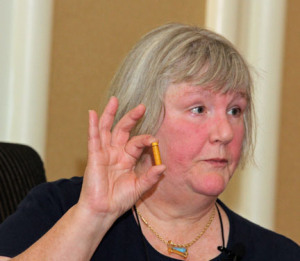
Luci Zahray, aka, The Poison Lady, holds a 24-milligram e-cigarette cartridge during her talk at Malice Domestic. Photo used with permission by G.J. Puhl.
Domestic this year. I had heard Luci speak twice in the last decade, but she varies her presentation so I always learn something new, plus she has that funny southern sense of humor and is a delight for the entertainment value alone. And now I know exactly what the murder weapon will be in my next mystery. (Dibs…)
Here are just two of the common poisons she described. Caveat – this post is from my hastily typed notes during the session. Please check the information out for yourself before using it – in your books, of course!
Nicotine. Luci said it is very dangerous to handle and in its liquid form nicotine can kill you from touching it. Two to three cigarettes would kill an adult, and one ingested cigarette butt would kill a child. You can now buy E-cig cartridges of pure nicotine anywhere. It costs $6.95 for six cartridges,  enough to kill two adults. It is stable and pure, and is absorbed through every part of the body. Death can be in as little as five minutes. 40 mg is a fatal dose. Death can also be delayed. If it’s ingested in liquid, death will be quick. If it’s applied on a Band-aid, for example, death can be delayed for an hour or so. In a heavy meal, death would be delayed for several hours.
enough to kill two adults. It is stable and pure, and is absorbed through every part of the body. Death can be in as little as five minutes. 40 mg is a fatal dose. Death can also be delayed. If it’s ingested in liquid, death will be quick. If it’s applied on a Band-aid, for example, death can be delayed for an hour or so. In a heavy meal, death would be delayed for several hours.
Death is from respiratory failure. Nicotine first stimulates the breathing then slows it down. Blood pressure correspondingly goes up and then down, then heart failure, coma, and death. A high dose can skip a few of those steps. Animals can be found dead with the plant still in their mouth. It has a mild tarry taste, but you can hide it. You can put ten to fifteen drops in a strong-tasting tea, coffee, chai, or a mocha latte. You can also buy flavored liquid nicotine in, for example, watermelon or bubblegum flavors. There is no antidote.
Rosary pea. You can grow your own, obtained on the Internet, or you can buy them as part of a rosary in a  Catholic store. It has red and black seeds, which contain abrin. Abrin is the third most toxic substance in the world. It’s a pretty shrub, can also be grown as a houseplant. One rosary pea in a child’s mouth can kill.; two to three seeds for an adult, if the dried seed has been pierced. You can put it in a soup, grind it in a grinder. It clumps up red blood cells and can imitate arsenic poison. Symptoms are delayed for hours or days. Nausea and vomiting are severe, with abdominal pain. A small dose is gradually toxic to the kidneys and liver. Four weeks later hair will fall out.
Catholic store. It has red and black seeds, which contain abrin. Abrin is the third most toxic substance in the world. It’s a pretty shrub, can also be grown as a houseplant. One rosary pea in a child’s mouth can kill.; two to three seeds for an adult, if the dried seed has been pierced. You can put it in a soup, grind it in a grinder. It clumps up red blood cells and can imitate arsenic poison. Symptoms are delayed for hours or days. Nausea and vomiting are severe, with abdominal pain. A small dose is gradually toxic to the kidneys and liver. Four weeks later hair will fall out.
Related: Castor beans have ricin. The castor bean has three seeds inside its shell, and eight beans can kill a whole room. Castor beans look like pinto beans. Two beans in a pot of chili will kill.
Poison gardens. Luci has a Texas back yard full of poisonous plants for her research, and she mentioned others in North Carolina (at the North Carolina Botanical Garden at UNC in Chapel Hill) and Philadelphia. Cornell University in Ithaca, New York has the Muenscher Poisonous Plants Garden. Blarney Castle in Cork, Ireland also has a Poison Garden, as does Amy Stewart in Eureka, California, the author of the excellent Wicked Plants: The Weed That Killed Lincoln’s Mother & Other Botanical Atrocities.
Luci recommended as a reference The North American Guide to Poisonous Plants and Mushrooms by Nancy J. Turner and Patrick von Aderkas, and the Home Health Guide to Poisons and Antidotes by Carol Turkington. Luci says you’re welcome to email her with questions and she’ll try to get back to you: lhzahray@hotmail.com. If you get a chance to hear her at a conference, go! You will not be disappointed.
Readers: What’s the best poison you’ve read about in a mystery or your favorite that you’ve used in your own writing to kill someone off? And what kind of expert would you like to see here next?
Filed under: Edith's posts Tagged: abrin, ecigarettes, liquid nicotine, Luci Zahray, Poison Lady, poisonous plants, ricin, rosary peas

July 10, 2014
I’m Just Not Worrying About It
Edith here, where it’s hot and windy like the desert.
But I’m not worrying about it. That’s my summer mantra this year.
So much to worry about in all aspects of life, and so little time. I could get very caught up  in, for example, worrying if I do enough promotion for my books. I’ll see that a friend, even a Wicked Cozy friend, has a guest post on a widely read blog that I guested on last year. I can worry about why I wasn’t asked this year, or that I forgot to invite myself. I can worry if I’ve contacted enough bookstores and libraries about my books, reached out to the wrong reading audience, forgotten to send a press release. And then worry that all will affect my sales.
in, for example, worrying if I do enough promotion for my books. I’ll see that a friend, even a Wicked Cozy friend, has a guest post on a widely read blog that I guested on last year. I can worry about why I wasn’t asked this year, or that I forgot to invite myself. I can worry if I’ve contacted enough bookstores and libraries about my books, reached out to the wrong reading audience, forgotten to send a press release. And then worry that all will affect my sales.
On the other hand, I could worry that I’m flogging my books TOO much, that potential readers are sick of me mentioning (gently, I hope) that a book is on sale this month, that I got a really nice review, or that my new newsletter is out. If they find all that irritating, will they drop me from their To Be Read pile?
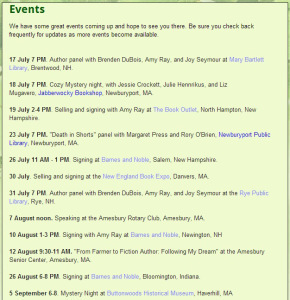 Ya know what? I’m not worrying about that. I’m here to write the best book I can, and then to write another one. I’ve done the best I can, and the Events tab on my web site looks pretty full for some months in a row. Well, then I could worry that I’m NOT writing the best book I can. Or that the best book won’t be good enough. I still haven’t heard if Kensington will renew the Local Foods contract. I’ve written an entire historical mystery that isn’t even under contract, and I could worry that it never will be, that no one will want to read it. I could definitely worry that my decision to quit my day job to write fiction full time was foolhardy.
Ya know what? I’m not worrying about that. I’m here to write the best book I can, and then to write another one. I’ve done the best I can, and the Events tab on my web site looks pretty full for some months in a row. Well, then I could worry that I’m NOT writing the best book I can. Or that the best book won’t be good enough. I still haven’t heard if Kensington will renew the Local Foods contract. I’ve written an entire historical mystery that isn’t even under contract, and I could worry that it never will be, that no one will want to read it. I could definitely worry that my decision to quit my day job to write fiction full time was foolhardy.
But I’m not going to worry about any of that. One could say there are more important things to worry about: will my retirement savings last, for example? Will my cats get sick 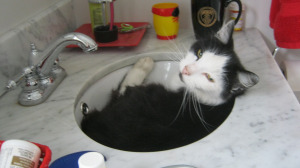 or run over? Will something disastrous happen to my health, to Hugh’s, to my sons’? What about world events? Climate change??
or run over? Will something disastrous happen to my health, to Hugh’s, to my sons’? What about world events? Climate change??
If I start worrying about all that, though, I’ll NEVER write any books. I’d never even leave the house, and might cower in a corner whimpering.
No, it’s summertime. I’m going to keep writing every morning, hit the beach near sunset, enjoy a G&T and a good mystery. I’ll continue to recycle, live frugally, drive my Prius conservatively,  and work for peace where possible. I have to assume that life will bring me what it will bring me, whether I worry or not.
and work for peace where possible. I have to assume that life will bring me what it will bring me, whether I worry or not.
Of course, as Hugh likes to say: to ASSUME just makes an Ass out of yoU and Me. One more thing not to worry about!
Readers: what do you worry about? What’s your best strategy for not worrying?
Filed under: Edith's posts Tagged: No worries, summertime

July 9, 2014
Wicked Wednesday – Keeping Series Characters Evolving
It’s Wicked Wednesday, when we all weigh in on a topic. This month, we’re focusing on craft, so naturally we’re starting the conversation with characters. Since we all write series, we’re constantly thinking about creating interesting, three-dimensional, continuously evolving characters. Today we’re sharing some of the ways we do that.
Liz: I’m constantly thinking about Stan’s evolution as I get deeper into the Pawsitively Organic series. It’s been so interesting to see her come alive from the original sketch I created for my proposal. Now, three books later, I’m watching her become a different person as she settles into her new life. She’s learning how to think outside of the structured environment in which she spent most of her adult life. She’s learning how to deal with a relationship that’s much more than a convenience thing. And she’s forced to explore a complicated relationship with her mother that she’s ignored for a long time. To get to the heart of why she’s doing certain things, I try to keep in mind what her motivation would be for everything – what makes sense based on who she is. And a lot of times, we’re discovering that together so it’s a fun process.
Edith: I hope Cam is evolving in the Local Foods Mysteries! I know readers have reported that they like her evolving relationships, and she’s certainly learning a lot about farming, at which she was a novice half a year before the series started. In the third book, Farmed and Dangerous, which takes place during a snowy January, she finds the strength to do a couple of things she thought she’d never have to (sorry, can’t reveal more or I’d spoil the plot!). Probably the main way she’s changing is getting out of her social isolation as a software engineer and learning how to be comfortable with people, which she has to do as a farmer. But what Liz says is true – we have to always keep the character’s motivation in mind.
that they like her evolving relationships, and she’s certainly learning a lot about farming, at which she was a novice half a year before the series started. In the third book, Farmed and Dangerous, which takes place during a snowy January, she finds the strength to do a couple of things she thought she’d never have to (sorry, can’t reveal more or I’d spoil the plot!). Probably the main way she’s changing is getting out of her social isolation as a software engineer and learning how to be comfortable with people, which she has to do as a farmer. But what Liz says is true – we have to always keep the character’s motivation in mind.
Barb: Such a timely question for me as I work on my proposal for the next three books in the Maine Clambake Mystery series. In Clammed Up, Julia Snowden returns to the Maine harbor town of her birth to spend the summer leading the charge to save her family’s ailing clambake business. Complications ensue. She’s in love with a guy who will never follow her back to New York. What to do? It’s important to me that Julia keeps evolving, and that we don’t get stuck in this will-she-or-won’t-she relationship forever. After all, she’s thirty, not fifteen, and adults either do or they don’t. So the next three books will have a different question at their heart. And as soon as I know what it is, (and it gets the go-ahead from my editor), I’ll let you know!
Sherry: One of the story lines in the Sarah Winston Garage Sale Series is Sarah learning to live on her own. She married at nineteen and then at thirty-eight is divorced in Tagged for Death. She has to support herself for the first time too. She also lives across the country from her family so emotional support through a difficult time is another issue.
Jessie: The overall character arc for Dani, the protagonist in the Sugar Grove series involves her being taken more seriously by her family, her community and even by herself. In each of the books Dani grows herself as she grows her business. Little by little she is putting her own stamp on what has been a family endeavor and she gets stronger with each passing book.
I like creating growth situations for some of the supporting characters too, like Dani’s mother and sister. I think it makes for a richer story and I have a lot of fun exploring how Dani’s changes prompt some of theirs as well.
Readers: Have you seen the characters in the Wicked Cozys’ books evolve? What about in other series you love? Do you stop reading if the protagonist never changes?
Filed under: Group posts, Wicked Wednesday, Writing Tips Tagged: characters, craft, evolution, Julia Snowden, maine clambake mysteries

July 8, 2014
Beach Bum
By Liz, packing a cooler, umbrella and some beach towels!
I’m on vacation this week, which means I’m in beach mode. I’ve always been a beach bum – I love the sound of the waves, the feel of the sand, the seagulls, the startling cold of the water the first time I’m brave enough to jump in. I love boogie boarding and sacking out in a chair with a good book and some snacks. I also love the beach at sunset, when everyone’s clearing out and we can sneak the dogs in for a quick swim. 
The beach has been a huge part of my life ever since I was a kid. I remember waking up on sunny summer days, hopeful that my mother would utter the magic words: “Get your bathing suit on!” On those days, we’d pack the cooler super early and head out to Salisbury Beach, about a twenty-minute drive from our house in Methuen. My mother had a friend named Mrs. Margraff, who let us park at her waterfront house and claim a spot on “her” beach. I don’t think I ever met Mrs. Margraff, but she was one of my favorite people ever for opening her magical beach house to us.
I have so many memories of those days that return every time I hit the sand: the anticipation of climbing up the walkway toward the dunes, knowing that once I reached the top of the sand the miles and miles of ocean would take my breath away; the friends I made; the hours of swimming turning my fingers into wrinkly prunes. As I got older, the memories changed – “cruising” the Hampton Beach strip with high school pals, volleyball on the beach with friends, stolen Saturdays when I’d sneak away alone with a pile of books to keep me company on the sand.
I still try to go as often as I can. Living in Connecticut, I haven’t been able to embrace the beaches here. The Sound is beautiful, but I need waves. Rhode Island has some beautiful beaches, and it also has the Cliff Walk – one of my favorite places of all times. It’s a path built into the cliff above the ocean, behind some of the famed Newport mansions. It’s seen some erosion over time, but it’s still one of the most amazing places on earth.
 I’m also lucky enough once a year to visit Old Orchard Beach in Maine, when the Wickeds gather on our yearly retreat at Jessie’s. I’m so grateful to her for opening her doors and for giving me another view of the ocean.
I’m also lucky enough once a year to visit Old Orchard Beach in Maine, when the Wickeds gather on our yearly retreat at Jessie’s. I’m so grateful to her for opening her doors and for giving me another view of the ocean.
There’s just something about the beach, no matter what time of day or time of year. It’s soul-renewing, it’s inspiring, it’s grounding. It’s the place I can always go to find answers and know they’ll be there, if I just wait long enough.
Readers, what’s your happy place?
Filed under: Liz's posts Tagged: beach, fun, inspiration, Liz Mugavero, ocean, Pawsitively Organic Mysteries, sand, summer, swimming

July 7, 2014
New Kid in Town
by Sheila Connolly
Being the new kid in town isn’t easy. I didn’t want to be here at all, and I sure didn’t want to have to meet all the local kids and try to make friends with ‘em. Some of them are okay, but there are others who think they have to show me just how tough they are. I don’t much like to fight, but sometimes you gotta do what you gotta do. Wish I could say things were getting better, but I’d be lying.
What is this? The opening to a new cozy, or maybe a YA novel? Nope, it’s about cats.
A few weeks ago an unfamiliar cat showed up in the neighborhood. Ours is a neighborhood that has more cats than dogs, and we’ve met most of them at one time or another. We have two cats, but they’re inside cats, although they know most of the locals because they sit on our screened porch and watch them. Our neighbors next door have a lovely tiger named Henry, who comes over to our house and very politely asks for a snack (yes, his owners feed him well). Softies that we are, we give him one.
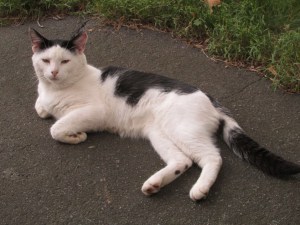
The New Cat
But back to the new cat. We think he was abandoned. When he first showed up he was very vocal—he’d wander the neighborhood yowling. While he’s male, we don’t know him well enough to check if he’s had The Operation, but I don’t think he was looking for love–he was hungry. And distressed.
He kept making the circuit of our block, and, as I’m sure you can guess, we started feeding him. He is pathetically grateful. It also became clear that he isn’t a feral cat, because he’s happy to have us pet him, although we haven’t quite reached the sit-on-the-lap stage. But he’s definitely used to humans and contact.
Why am I rambling on about a stray cat? Because I realized that watching New Cat introduce himself to the other cats around here has been kind of a microcosm for species interactions—and useful for writing.
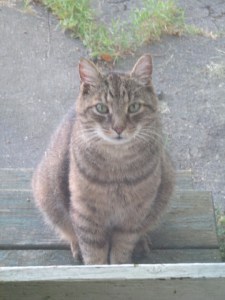
Henry, waiting for his snack
New Cat was spooked at first, since he wasn’t used to surviving on his own. He made his first social overtures to Henry next door, and soon he was sharing Henry’s back porch with Henry occasionally, rolling over and baring his tummy. Submissive behavior, right? Henry is a very considerate cat, so he accepted New Cat politely, and they seem to get along fairly well. Henry still claims first rights to any plate of food, but he’ll leave some for New Cat. New Cat waits his turn.
Then New Cat started interacting with our sibling cats, Dexter and Lila, through the porch screen. Ours are very easy-going and friendly, so they were more curious than hostile. They’d sniff noses through the screen. Our male hissed a few times—this is, after all, his turf—but they quieted down before long. Dexter is the gregarious cat of the pair, and soon enough he was doing the back-roll-tummy-bare thing with New Cat. Lila just watches.

Siblings Dexter (left) and Lila
I have to say that not all of New Cat’s interactions have been as happy—he came by one day with a bleeding ear, so he got into it with some unfriendly cat (I suspect the chunky all-black one that wanders by now and then, looking like a thuggish Harbinger of Doom).
Maybe there’s a cozy story in here somewhere. You know: stranger arrives in town, not necessarily by choice, and tries to make friends. Some neighbors welcome the newcomer, others are more hostile (like the evil Black Cat, the villain of the tale). So far the only body has belonged to a squirrel, and that was Henry’s doing—or at least, he disposed of the evidence. Fitting in at a new place involves patience, and a degree of politeness. And for a cat, it may also mean fitting in with the humans, so they keep feeding you, which is greatly helped along by a display of gratitude and affection. New Cat is not dumb.
I am in favor of adopting cats in need (and making sure they’ve had The Operation and all necessary shots). But most of our cats have been chosen, with the exception of a pathetic black kitten my husband found in his parking lot at work, years ago, who turned out to be one of the nastiest cats I’ve ever known. Which doesn’t explain why we kept her for twenty years. She didn’t get along with people or other cats. She bullied every other cat we had during her time with us. She also peed on carpets. But we always felt we had an obligation to her, since we’d taken her in.
But I don’t know what we’re going to do about New Cat. My sister-in-law, who has at least six cats ranging from wild to house-bound, says if you name a stray cat, you’re sunk. Uh, I have a name for New Cat. Cozies need happy endings, right?
Okay, one small plug for Razing the Dead (released last month), but only because it’s appropriate to Independence Day just past: the story revolves around one of the nastiest battles in the Revolutionary War, the Paoli Massacre in Pennsylvania. The monument on the battlefield today is the second oldest in the country; only the one at Concord is earlier.
Filed under: Sheila's Posts

July 4, 2014
Celebrate the Fourth!
Jessie: Blissfully beachside in Maine with family and friends
It’s been quite a week. Some of you may have noticed that all the Wickeds have been helping to celebrate the launch of my newest mystery, Maple Mayhem. Tuesday was the official publication date but the merriment has continued and the week has been wonderful. And one of the best parts is that the week ends with the celebration of Independence Day. 
I adore the Fourth of July. I love grilled foods and picnics of all sorts. I love sundresses and big, floppy hats. I have a childlike devotion to fireworks and sparklers. My husband and I even got married on the sixth which allows us to extend the festive atmosphere every year by two extra days.
I hope you have a chance to enjoy some old-fashioned fun this weekend and I hope you will help me to celebrate the end of this week by leaving a comment about your Fourth of July traditions, a favorite summer recipe or a best Independence Day memory. I’ll be giving away a copy of Maple Mayhem to one commenter and one of the first book in the Sugar Grove series, Drizzled with Death, to another.
Filed under: Jessie's posts, Uncategorized Tagged: book giveaway, cozy mysteries, Fourth of July, independence day




